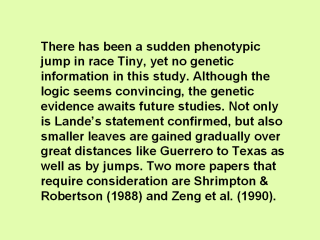 |
The only worthwhile comparative foliar
morphometrics are by Hilu et al. (1982) in California. They gave torreyana
as: 20.7 ± 4.4 LL, 77.0 ± 17.7 LR, 12.6 ± 2.4 PL, 1.1 ± 0.28 PR, 30.0 ± 15.3
LP (N = 90). They gave velutine as: 11.8 ± 0.8 LL, 65.6 ± 10.3 LR, 17.2 ±
4.1 PL, 1.40 ± 0.55 PR, 26.8 ± 18.1 LP (N = 17). 1.40 PR is 40 % double
rachis (2 PR). LL, LR & LP are in mm, whereas PL & PR are counts. See
abbreviations in Methods & Materials. Velutines have about 25 PL. Hilu et
al. also gave the average distance between the 5th & 6th leaflets as,
respectively, 6.1 ± 1.6 & 3.6 ± 0.6 mm, but velutines have overlapping
leaflets. Also, short leaflets are much proportionally broader than long
ones. Thus, the Hilu samples are somewhat diluted by torreyana backcrossing,
e. g., interleaflet space can be 2.7 ± 0.4 mm (N = 100). Read also Earl
(2003) on foliar measurements and design.
This paper supports the macrostep evolutionary theory of Lande (1983) as
given by Orr & Coyne (1992). The genetics of adaptation like that of
speciation is far from solidly defined, basically because still not enough
applicible data has been analyzed. Adaptation in Prosopis relates to smaller
leaves for drier niches. The Guaymas environment is drying out so that only
heat-resistant organisms will survive. |
